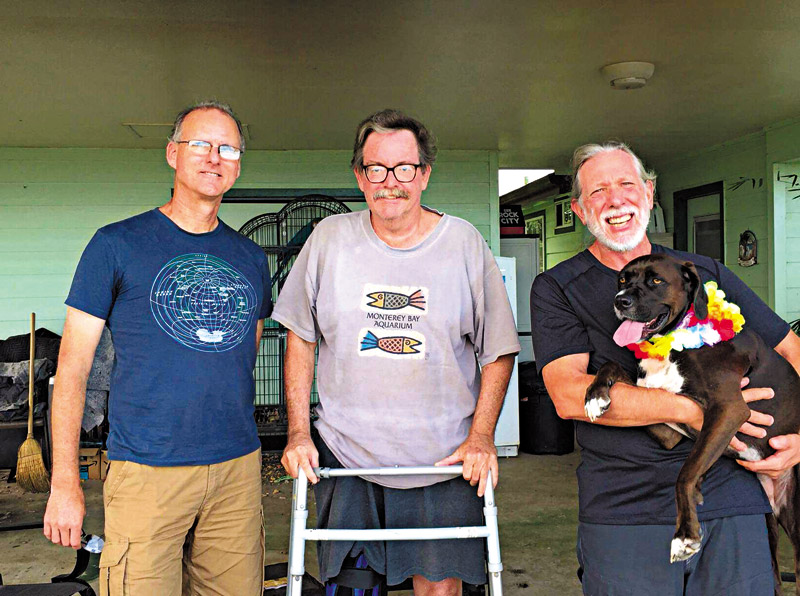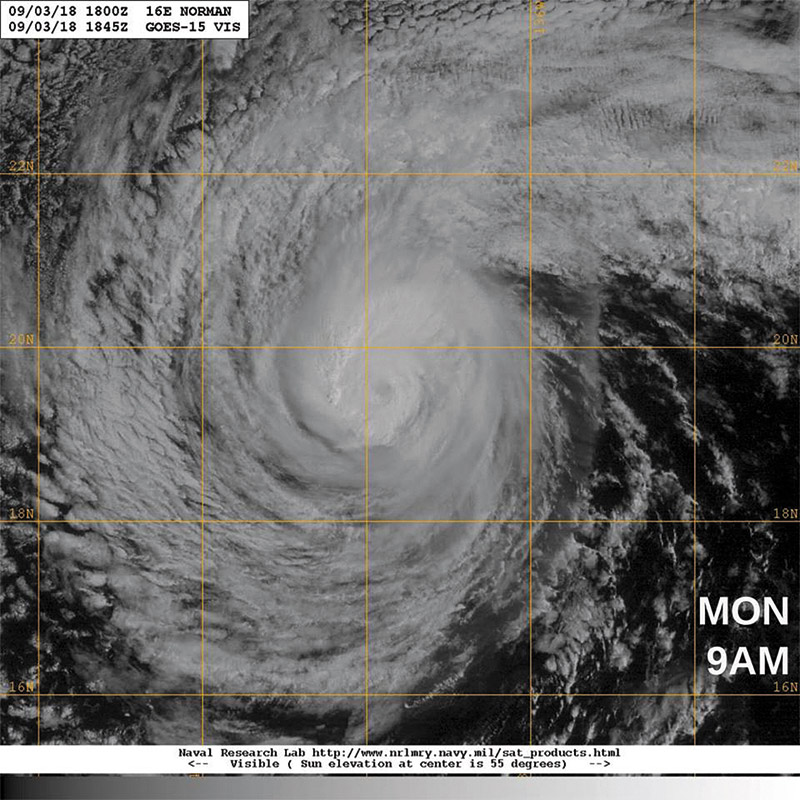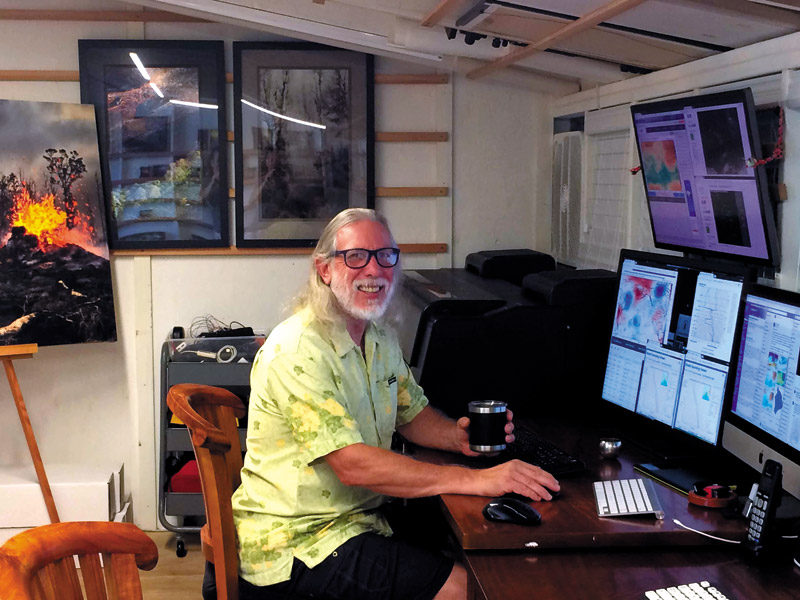The Puna Weather Guys

Weather is always on the minds of the Puna Weather trio (from left): retired U.S. Navy aerographer Mike Boucher; retired professor of tropical meteorology Mark Morrissey (nursing a broken leg); and pro photographer, scientist and Puna Weather founder Harry Durgin holding “Little.” Not pictured is Bob Farrell, former lead National Weather Service Forecaster in Honolulu and an AMS-certified meteorological consultant.
Early one Saturday morning, a group of weather geeks gathered online, spending several hours discussing the status of multiple systems and disturbances converging within range of the Hawaiian Islands. The previous week, they had analyzed data and posted information as Hurricane Lane came worryingly close to the islands before dumping record rainfall and finally getting torn apart by shear. Some members of the group are former weather professors or professionals, while others are self-taught meteorology enthusiasts. But all of them — Harry Durgin, Mark Morrissey, Mike Boucher and Bob Farrell, retired and living in Puna — are passionate about the weather and the way it affects Hawai‘i Island.
That’s a good thing for residents, who often complain that they don’t receive detailed weather forecasts for their island from the Honolulu-based news channels, that seem mainly focused on what’s happening on O‘ahu. But now, when storms begin skittering around the islands during the hurricane season from June through November, Big Island folks have a place to turn to for truly local analysis, forecasts, predictions, camaraderie and yes — even comfort. That place is “Puna Weather,” a public Facebook group consisting of 3,431 members and counting.
“I wanted to start a group that would become a community service, one that would bond the community while providing scientific outreach, allow for thoughtful discourse, and provide a place for scientific culture to thrive while offering the opportunity for people to improve their critical and analytical thinking skills,” says Durgin, a retired businessman and accomplished professional photographer.

Data and imagery from a recent Puna Weather post on Facebook.
Thus, Puna Weather was born in 2014 during the approach of Hurricane Iselle, which battered the eastside of the Big Island, causing widespread damage and famously downing scores of albizia trees. The group attracted members islandwide who liked the easy-to-understand weather discussions. On the internet, where hurricane rumors quickly grow a life of their own, Durgin quickly became the voice of science and reason for thousands of Facebook followers.
Always interested in math, science and meteorology, Durgin, a computer scientist by trade, studied journals, articles, theories and books to bring himself up to speed on the intricacies of weather science. When he posts an analysis on Puna Weather, it’s carefully researched and includes photos, satellite imagery, data, charts, graphs, models and more. The detailed posts appeal to a broad spectrum of readers — from the complete weather novice to seasoned pros.
“It’s great checking in with Puna Weather when a hurricane is approaching,” says member Kyle Jones. “Clearly they know what they are talking about, and I trust the science behind their posts.”
Fortunately, Durgin got the chance to take Puna Weather to another level and collaborate right here on-island with other experts in weather science and meteorology. Their teamwork during Hurricane Lane helped give Big Island residents a frequently updated and comprehensive account on what was happening and what they might expect to happen with the potentially frightening storm.

For Durgin, many of his days are spent looking at maps and analyzing satellite data.
Morrissey, a professor emeritus of meteorology at University of Oklahoma, who earned his Ph.D. in tropical meteorology at University of Hawai‘i at Mānoa, makes his home today in Mountain View. Farrell, a classmate of Morrissey’s and former lead National Weather Service forecaster, and AMS-certified meteorological consultant, is also a member. So is Boucher, a Volcano resident. He worked for decades as a Navy aerographer, observing, collecting and analyzing meteorological information, including atmospheric and ocean conditions.
Together, this team used their considerable brainpower to analyze and post about the approach and the potential impacts of Hurricane Lane.
Durgin explains how the team works: “We look at maps, models, satellite data and more, correlate what we’re seeing and go back and forth a while, discussing and analyzing, before eventually agreeing on what to post.”
Durgin’s wife, Mouse-Marie, who observes the group in action, adds, “Each of these guys spent countless hours working with Harry behind the scenes this past week (during the Hurricane Lane event). They created a working group, wrote a bunch of computer scripts to make the tools they need and gather the data they need, and are at it hard from early in the morning until late at night. It’s a truly beautiful thing to watch.”
So what about the burning question on everyone’s mind? Is the Big Island really protected from hurricanes by the mountains? Or is that a myth?
“The Hawaiian Islands rarely get hit by dead-on hurricanes,” explains Morrissey. “We have a semi-permanent natural zone of protection consisting of vertical shear. (Officially called the “Tropical Upper Tropospheric Trough,” or TUTT.) Hurricanes can’t survive it. We have had hurricanes hit the Islands (‘Iniki and ‘Iwa, for example), but it’s really very rare — maybe four or five in the last 100 years?
“As for the mountains, they definitely can disrupt the circulation, but the hurricane needs to get close enough for that interaction to occur. It doesn’t happen before they get here.”
Morrissey believes that hurricanes are actually very fragile things.
“They do best (strengthening) when they are in a place where nothing is happening,” he says. “But then they will weaken rapidly, especially when entering a shear zone, which is what happened to Lane. In the case of Lane, it survived longer than I thought it would. But once it moved into the shear zone, bang, it was done for.”
As for operations at Puna Weather, members can always expect job security, as there will always be weather to discuss. In the future, Durgin sees expansion of the group with the help of empowering grants, the growth of social media, and the hope that it will spawn other groups that influence and encourage people’s critical thinking and self-reflective skills. He wants the group to be bi-directional — to get data back as well as put data out there. And then, of course, there is the natural bonding of the members that is so satisfying.
“We’re all in this together under the rain,” Durgin quips.

